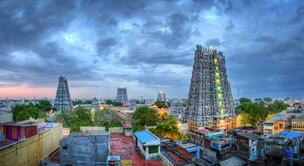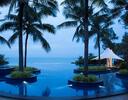Religious Tour of Southern India

Southern India is considered as the heavenly home of various magnificent monuments which have stood tall in all their glory since ages. The monuments of South India are breathtakingly beautiful and grand in every sense of the word, starting from the beautiful Dravidian architecture to the grand Vijayanagar style of architecture and many more such fine examples.
The temples here are not only beautiful and attractive in their architecture, but also offer a sense of peace and fill you with a particular charm. South Indian shrines are one of the best examples for their various legends.
Itinerary
- Day 1
Arrival Chennai / Transfer to Tirupati
Upon arrival at Chennai Airport, transfer to Tirupati [130 kms. - 3 to 4 hours drive]
Tirupati [Tirulama] the abode of Lord Venkateswara, is one of the 8th most sacred places of Maha Vishnu, hailed as Swayamvvakta Kshetras (self-manifested)
One of the globe's largest pilgrimage destinations, the holy hill of Tirumala is, on any given day, thronged with thousands of devotees who've journeyed to venerate Lord Venkateshwara here, at his home. Around 60,000 pilgrims come each day, and darshan runs 24/7. The Tirumala Tirupathi Devasthanams efficiently administers the multitudes, employing 20,000 people to do so. Despite the crowds, a sense of order, serenity and ease mostly prevails, and a trip to the Holy Hill can be fulfilling even if you’re not a pilgrim. Queues during the annual nine-day Brahmotsavam festival can stretch for kilometres.
Tirupati, the humdrum town at the bottom of the hill, is the functional gateway to Tirumala.
On arrival check in at Hotel
Later transfer to Tirumala for Darshan [We will pre-book the darshan tickets]
Tirumala Tirupati Devsthanam
Devotees flock to Tirumala to see Venkateshwara, an avatar of Vishnu. Among the many powers attributed to Venkateshwara is the granting of any wish made at this holy site. Legends about the hill itself and the surrounding area appear in the Puranas, and the temple’s history may date back 2000 years. The main temple is an atmospheric place. Venkateshwara inspires bliss and love among his visitors from the back of the dark and magical inner sanctum; it smells of incense and resonates with chanting. You’ll have a moment to say a prayer and then you’ll be shoved out again. Don’t forget to collect your delicious ladoo from the counter: Tirumala ladoos (sweet balls made with chickpea flour, cardamom and dried fruits) are famous across India.
Many pilgrims donate their hair to the deity – in gratitude for a wish fulfilled, or to renounce ego – so hundreds of barbers attend to devotees. Tirumala and Tirupati are filled with tonsured men, women and children.
Later return back to the hotel
Overnight at Tirupati - Day 2
Tirupati to Mahabalipuram
After breakfast, transfer to Mahabalipuram [190 kms. - 4 to 5 hours drive]
Mahabalipuram has been named so since the demon king Mahabali was killed by Lord Vishnu here. The name was changed later to Mallapuram by the king of Pallava Narashima Varman who has got the title of Mamalla - the great wrestler
Mamallapuram, 50km south of Chennai, was the major seaport of the ancient Pallava kingdom based at Kanchipuram. A wander around the town’s magnificent, World Heritage–listed temples and carvings inflames the imagination, especially at sunset.
In addition to ancient archaeological wonders, salty air and coastal beauty, there’s also the traveller hub of Othavadai and Othavadai Cross Sts, where restaurants serve pasta, pizza and pancakes, and shops sell Tibetan trinkets.
Check in at hotel on arrival
Later, day at leisure for local sightseeing
Panchapandava Caves
The Panchapandava Cave is a part of the Group of Monuments at Mahabalipuram. Interestingly, it is named after the Pancha - Pandavas (five Pandavas) of the epic Mahabaratha.
The Panchapandava Cave Temple is simple and elegant. It is a rectangular structure which is carved out of the rocks and supported by the pillars. The facade of the cave consists of stone-pillars with lion caryatid (carved lions on the pillars). It looks like these lions-sculptures are supporting the pillars. However, they definitely give a royal look to the cave temple. Though it looks very simple, this cave seems to be the improvised version when compared to few other monuments in the group. Intricate carvings on the walls of the cave, pillars with griffins, small verandah, rock-cut chambers look like perfect and symmetrical.
Krishna Temple
A stunningly beautiful bas-relief showing Krishna lifting the Govardhana mountain in order to protect the cows and the cowherds from the wrth of Indra, the god of rain, is the highlight of this cave temple.
The Shore Temple
This is the oldest temple in south India. It belongs to the early part of the 8th century and is a good example of Dravidian art. Originally, there were seven such temples called as pagodas and only one has been spared.
Arjuna’s Penance
This a complicated magnificent piece of skilfully carved work, the largest bas-relief sculptures in the world. Arjuna, the epic hero of Mahabharata, is depicted here as sage doing penance in order to obtain the divine weapons from Lord Shiva. All the carvings are made out of a huge boulder. There is a natural cleft in the centre of the huge rock which is conceived as the sacred river Ganga descending to earth. Various divine figures have been carved on all the sides. This piece of work is a masterpiece of creation in expression, particularly the figures relating to the popular Panchatanthra stories.
Mahisasuramardini Cave
This is another excellent bas-relief depicting Lord Vishnu sleeping on the coils of serpent king Adisesha and goddess Durga fighting with demon king Mahishasura.
Varaha Temple
Lord Vishnu is shown in this cave temple in the incarnation of Varaha (boar) and the Vamana as a dwarf. This is an exquisitely caved bas-relief.
Rathas
There rock-cut temples, named after the five Pandava brothers and Draupadi are the excellent examples of the Pallava art. All the five monuments are called Rathas as they are full sized models and look like the chariots of the temple. However, they recall the earlier architecture of the Buddhist chapels and monasteries. In addition, the Ganesha Ratha in the north side is also a beautiful piece of art. The architecture resembles Dravidian temples with their imposing towers and multi-pillared halls and sculptured walls.
Mandapams
Shallow halls resembling porticoes in various parts of the area, some of them left in an unfinished condition. These are remarkable for their sculpture combined with simple architectural treatment. About 4km away is the cave temple complex of Aluvan Kuppam. The Tiger Cave is an excavated cave shrine with aureole of Lion heads. It was an open theatre where cultural programmes were held in the past.
Overnight at Mahabalipuram - Day 3
Mahabalipuram to Pondicherry
After breakfast, transfer from Mahabalipuram to Pondicherry [100 kms. - 2 to 3 hours drive]
A Tamil culture with a strong French flavor and loads of cosmopolitan tendencies make Pondicherry, a place definitely worth a visit. Blessed gracefully by nature, the entire region is dotted by pretty water bodies, stretching greens and a serene ambience. Mostly untouched and least crowded, the calm and serenity that Pondicherry affords is simply amazing
The union territory of Puducherry (formerly Pondicherry; generally known as Pondy) was under French rule until 1954. Some people here still speak French (and English with French accents). Hotels, restaurants and ‘lifestyle’ shops sell a seductive vision of the French-subcontinental aesthetic, enhanced by Gallic creative types and Indian artists and designers. The internationally famous Sri Aurobindo Ashram and its offshoot just north of town, Auroville, draw large numbers of spiritually minded visitors. Thus Pondy’s vibe: less faded colonial-era ville, more bohemian-chic, New Age–meets–Old World hang-out on the international travel trail.
The older 'French' part of town (where you'll probably spend most of your time) is full of quiet, clean streets, lined with bougainvillea-draped colonial-style townhouses numbered in an almost logical manner. Newer Pondy is typically, hectically South Indian.
Enjoy fabulous shopping, French food (hello steak!), beer (au revoir Tamil Nadu alcohol taxes), and plenty of yoga and meditation.
Check in at hotel on arrival
We recommend you visit the Auroville today & register for visit to Matri Mandir for tomorrow or day after based on available slots [pre-booking not possible. They have a system of only spot booking]
Rest of the evening at leisure to rest at hotel or visit Aurobindo Ashram at Pondicherry
Aurobindo Ashram - Sri Aurobindo Ashram, founded in 1920, is the residence where the Sri Aurobindo and revered Mother Mirra Richard, popularly known as Maa, spent the most part of their life. This place attracts many thousands of people each year. This is the saddle of peace; Aurobindo preached his ideas of a peaceful community from this ashram. The ashram is comprised of many buildings and the inmates are a diversified community of around 1,200 members with 400 students of the Centre of Education. This ashram has different departments to maintain the basic needs of its members. Members engage in various activities in farms, libraries, gardens, and small-scale industries like printing press. The ashram draws lots of respect as the Samadhi place of Sri Aurobindo and the mother.
Overnight at Pondicherry - Day 4
Pondicherry
After breakfast, day at leisure for local sightseeing
Auroville & Marti Mandir - A real example of community living and gradually flourishing, Auroville is conceived as a ‘Universal Town’. This is a place were people with different nationalities, beliefs and culture live in harmony. This amazing city of community living was started in 1968 by the Maa, renowned disciple of Shri Aurobindo, and now the development is going on. Nearly 50 languages are spoken here. The star attraction of Auroville is The Matrimandir – A meditation centre. It is a shrine of the Universal Mother and the Soul of Auroville; it is meant for those who, in the Mother's words, are sincere and serious and truly want to learn to concentrate. The Matri mandir is not a temple in the conventional sense of the word; it is neither a place of worship, nor to be associated with any religion, whether ancient, present, new or future. For an opportunity to Meditate at Matri Mandir, one has to seek appointment in person between 10 to 11 or 3 to 4 on a particular day [Tuesdays closed]. The appointment is granted for the next day based on the available time slot.
Raj Niwas - Palais du Gouvernement, an eighteenth century building, presently known as Raj Nivas is a main attraction in Pondicherry. Raj Nivas, the residence of Pondicherry's Lieutenant Governor, is not open to the public. The old court, which houses the Legislative Assembly, is also seen in this building. One of the main attractions for the tourists is the monolithic pillars, brought from Gingee Fort after its capture in 1751. Another attraction is the water monument placed in the middle of a well-maintained garden, which is the monument of the reminiscence of the introduction of good drinking water scheme for the population.
Pondicherry Beaches - Pondicherry has some of the stunning beaches which attract tourists from all over the world in search of seclusion and tranquility. If you are a sun worshipper or a beach lover then this part of the world presents you miles of paradise. The cool sea waters and the sparkling white sand welcome you to leave behind all the worldly troubles and spend some time in the peaceful ambience of this beautiful place. Among the various Pondicherry beaches, Mahe beach in Pondicherry needs special mention. The other beaches are Serenity beach, KaraikalBeach and Plage Paradiso (Paradise Beach).
Botanical Garden - The Botanical Gardens in Pondicherry was opened to the public in 1826 and is located at the southern entrance of city bus stand. While you surf the variety of things in the Botanical Gardens in Pondicherry, you'll come across a lot of information about the trees like the uses of the trees, amount of oxygen they give out and their medicinal value. Here you will get the chance of seeing a mix of endangered and exotic species of plants There are 28 plots dividing the Botanical Garden and each have a separate theme. This garden came to existence after an experiment in 1826 by the French colonists to analyze the crops that could be cultivated in that region. Later trees were planted here and slowly it grew into a full fledged Botanical Garden. Some of the attractions you will love to see and the kids will enjoy at the Botanical Gardens of Pondicherry are : Children’s train, Six fountains, A dancing fountain, Japanese rock, Aquarium with ornamental fish.
Overnight at Pondicherry - Day 5
Pondicherry to Tiruchirappalli [Trichy]
After breakfast, transfer to Tiruchirappalli [Trichy] [200 kms. - 4 to 5 hours drive]
Tiruchirappalli, situated on the banks of the river Cauvery is the fourth largest city in Tamil Nadu. It was a citadel of the early Cholas which later fell to the Pallavas. Trichy is a fine blend of tradition and modernity built around the Rock Fort. Apart from the Fort, there are several Temples dating back to the 1760s
Welcome to (more or less) the geographical centre of Tamil Nadu. Tiruchirappalli, universally called Trichy or Tiruchi, isn’t just a travel junction: it also mixes up a heaving bazaar with some major temples. It's a huge, crowded, busy city, and the fact that most hotels are clumped together around the big bus station isn't exactly a plus point. But Trichy has a strong character and long history, and a way of overturning first impressions.
Trichy may have been a capital of the early Cholas in the 3rd century BC. It passed through the hands of the Pallavas, medieval Cholas, Pandyas, Delhi Sultanate and Vijayanagars before the Madurai Nayaks brought it to prominence, making it a capital in the 17th century and building its famous Rock Fort Temple. Under British control, it became an important railway hub known as Trichinopoly.
Check in at hotel
Later depart for sightseeing
Rock Temple [9 Kms – 20 min drive]
The Rock Fort Temple, perched 83m high on a massive outcrop, lords over Trichy with stony arrogance. The ancient rock was first hewn by the Pallavas and Pandyas, who cut small cave temples on its south side, but it was the war-savvy Nayaks who later made strategic use of the naturally fortified position. Reaching the top requires climbing over 400 stone-cut steps.
Lord Brihadeeswarar Temple in Thanjavur [60 Kms – 2 to 3 hrs drive]
The Big Temple of Thanjavur is a stunning monument that speaks oodles about the architectural mastery of the Chola era. This 212 ft (64.8 meter) towering Shiva temple is home to one of the largest Shiva Lingas of the country. A majestic Nandhi (bull), measuring a gigantic 19.4 ‘ x 8.23’ x 12’ (5.94 x 2.51 x 3.66 in meters) stands guard over the temple. This is the second largest Nandhi in India and is carved out of a single stone. Everything about this temple is big, majestic. No wonder it is referred as The Big Temple.
Lord Brahadeeshwarar Temple, Thanjavur built in between 985 AD - 1013 AD by the Great King Raja Raja Chola is a World Heritage Monument. Later rulers of the region Pandiyas, Nayaks and Marathas have contributed to the development of the temple. The temple is repository of Art and Culture and is an architectural marvel.
Drive back to Triruchirappalli by evening
Overnight at Trichy - Day 6
Trichy to Madurai
After breakfast, transfer to Madurai [130 kms. - 2 to 3 hours drive]
One of South India's great temple towns, Madurai is synonymous with the celebrated Meenakshi Temple. Situated on the banks of river Vaigai, Madurai has a rich cultural heritage passed on from the great Tamil era more than 2500 years old. Madurai was an important cultural and commercial centre even as early as 550 AD. It was the capital city for the great Pandya kings
Chennai may be the capital of Tamil Nadu, but Madurai claims its soul. Madurai is Tamil-born and Tamil-rooted, one of the oldest cities in India, a metropolis that traded with ancient Rome and was a great capital long before Chennai was even dreamed of.
Tourists, Indian and foreign, come here for the celebrated Meenakshi Amman Temple, a dazzling mazelike structure ranking among India's greatest temples. Otherwise, Madurai, perhaps appropriately given its age, captures many of India’s glaring dichotomies: a centre dominated by a medieval temple and an economy increasingly driven by IT, all overlaid with the hustle, energy and excitement of a big Indian city and slotted into a much more manageable package than Chennai’s sprawl.
Check in at hotel
Once settled, visit the Meenakshi Temple [Visiting hours: 0500 to 1230 hrs & 1600 to 2200 hrs]
The enormous temple complex is dedicated to Shiva, known here as Sundareshvara and his consort Parvathi or Meenakshi. The original temple was built by Kulasekarar Pandya, but the entire credit for making the temple as splendid as it is today goes to the Nayaks. The Nayaks ruled Madurai from the 16th to the 18th century and left a majestic imprint of their rule in the Meenakshi – SundareswararTemple.
The temple complex is within a high-walled enclosure, at the core of which are the two sanctums for Meenakshi and Sundareshvara, surrounded by a number of smaller shrines and grand pillared halls. Especially impressive are the 12 gopuras. Their soaring towers rise from solid granite bases, and are covered with stucco figures of dieties, mythical animals and monsters painted in vivid colours.
Overnight at Madurai - Day 7
Madurai to Rameshwaram
After breakfast, transfer to Rameshwaram [180 kms. - 3 to 4 hours drive]
Rameshwaram is an island situated in the gulf of manner at the very tip of the Indian peninsula. A very important pilgrim centre of the Indians, Rameshwaram is the place from where Lord Rama, built a bridge across the sea to rescue his consort Sita, from her abductor, Ravana. This is also the place where Rama worshipped Lord Shiva to cleanse away the sin of killing Ravana. Both the Vaishnavites and Shaivites visit this pilgrimage which is known as the Varanasi of south
Rameswaram was once the southernmost point of sacred India; leaving its boundaries meant abandoning caste and falling below the status of the lowliest skinner of sacred cows. Then Rama (incarnation of Vishnu, hero of the Ramayana) led a monkey-and-bear army across a monkey-built bridge to (Sri) Lanka, defeating the demon Ravana and rescuing his wife, Sita. Afterwards, prince and princess offered thanks to Shiva here. Today, millions of Hindus flock to the Ramanathaswamy Temple to worship where a god worshipped a god.
Otherwise, Rameswaram is a small, scruffy fishing town on conch-shaped Pamban Island, connected to the mainland by 2km-long bridges. If you aren't a pilgrim, the temple alone barely merits the journey here. But the island's eastern tip, Dhanushkodi, only 30km from Sri Lanka, has a magical natural beauty that adds to Rameswaram's appeal. And for activity-loving travellers, the island's western edge is buzzing as a low-key water-sports destination.
Check in at hotel
Later depart for local sightseeing
Ramanathaswamy Temple
Ramnathswamy temple was built in the 17th century. Situated close to the sea on the eastern side of the island, this temple is famous for its 1200 gigantic granite columns. The 54 metre tall gopuram (gate-tower), 1220 metres of magnificent corridors and the flamboyant columns embellish and render fame to the temple. The water in each of the 22 sacred wells in the temple tastes different.
Agnitheertham
100 metres away from the temple is Agnitheertham, where Rama worshipped Lord Shiva, to absolve himself from the killing Ravana.
Gandamadana Parvatham
The imprint of Lord Rama's feet placed on a Chakra (wheel) is found in this shrine which is at the highest point on the island at 2 km from Rameshwaram.
Dhanushkodi
Dhanushkodi named after Rama's bow, is at the eastern end of the island at a distance of 8 kms from Rameshwaram. The boulders around the sea between Sri Lanka and this place known as Adam's bridge are believed to be used by Hanuman to reach across Sri Lanka. Dhanushkodi was completely destroyed by the cyclones of 1964. Kothandaramaswamy temple is the only salvage of the cyclone. Idols of Rama, Sita, Lakshmana, Hanuman and Vibhishana (brother of Ravana), who surrendered to Rama, are placed here.
Overnight at Rameshwaram - Day 8
Rameshwaram to Kanyakumari
After breakfast, transfer from Rameshwaram to Kanyakumari [310 Kms / 5 to 6 hrs drive]
There are no words that can completely describe the beauty of Kanyakumari and it remains one of the most popular tourist destinations of south India. Located in the southernmost point of the Indian mainland, it is a magnificent place of natural beauty where you can see the deep blue waters of the ocean meeting the horizon. This southernmost town of Tamil Nadu is an important attraction for the tourists.
This is it, the end of India. There’s a sense of accomplishment on making it to the tip of the subcontinent's 'V', past the final dramatic flourish of the Western Ghats and the green fields, glinting rice paddies and slow-looping wind turbines of India's deep south. Kanyakumari can feel surreal; at certain times of year you'll see the sun set and the moon rise over three seas (Bay of Bengal, Arabian Sea, Indian Ocean) simultaneously. The Temple of the Virgin Sea Goddess, Swami Vivekananda's legacy and the 'Land's End' symbolism draw crowds of pilgrims and tourists to Kanyakumari, but it remains a small-scale, refreshing respite from the hectic Indian road.
Check in at Hotel
Later day free for local sightseeing of Kanyakumari
Kanyakumari Temple
Kanyakumari Temple is also referred to as Bhagvaty Amman Temple and is one of the 108 Shakti Peetha in Hindu mythology. The temple is one of the major Hindu temples across India and is mentioned in almost all the ancient Hindu scriptures. The temple is frequented by thousands of pilgrims each year and the temple’s architecture is also unique.
Vivekananda Rock
It was built in 1970. Vivekananda Rock Memorial is dedicated to Swami Vivekananda, the greatest social reformer and saint modern India has produced. Swami Vivekananda was supposed to have meditated on the rock where the memorial stands today at the end of the year 1892 before his departure for Chicago to participate in the world religious conference in 1983. The memorial stands today at this place. Meditation hall is also attached with the Memorial. Visiting Hours : 8 Am to 4 Pm
Kumari Amma Temple
KumariAmmanTemple id dedicated to Parvathi as Devi Kanya the virgin goddess who did penance to obtain the hand of Lord Shiva. Darshan Timings: Between 04 am and 1200 noon and again between 4 pm to 8 pm
Gandhi Memorial
On Mahatma's Birthday (October 2nd) Sun rays fall on the spot where his ashes were placed before immersion. "I am writing this at the Cape, in front of the sea where three seas meet and furnish a sight unequalled in the world, for this is no port of call for vessels. Like the Goddess, the seas around are virgin" -- Mahatma Gandhi
Indira Point
The Indira Point is well renowned for its beaches, circumscribed by natural environs. The place provides a soothing relief from the hustle and bustle of the modern world. Besides its breath taking scenic beauty and mesmerizing surroundings, Indira Point is famous for its sky scarpering Lighthouse. Entrenched in 1972, the Indira Point Lighthouse derived its nomenclature in the beloved memory of the fourth Prime Minister of India, Smt. Indira Gandhi.
Thiruvalluvar Statue
The Thiruvalluvar statue has been erected on one of the twin rocks offshore, and nearby Vivekananda Rock Memorial. Height of the Statue is 133 foot. An imposing Memorial of Thiruvalluvar.
Overnight at Kanyakumari - Day 9
Kanyakumari to Trivandrum / Departure
After breakfast, morning at leisure
Later, transfer from Kanyakumari to Trivandrum airport [100 Kms / 2 to 3 hrs drive] for onward flight.
Notes
Round the Year Destination ... Extension recommended to destinations across Kerala viz; Kovalam, Kumarakom, Thekkady, Munnar, Athirapally, etc.
Hotels
Tour Inclusions [Religious South]
1 night stay at Tirupati
1 night stay at Mahabalipuram
2 nights stay at Pondicherry
1 night stay at Trichy
1 night stay at Madurai
1 night stay at Rameshwaram
1 night stay at Kanyakumari
Daily breakfast at hotels
All transfers, inter-city travel & sightseeings by chauffer driven vehicle
Notes on itinerary
All our itineraries are "Just for Ideas" ... We will get to know you and customise an itinerary just for you that matches your requirements ... dates of travel, category of hotels, preferred airline, flexibility in choosing sightseeing, mode of travel between cities, etc.
Many of our clients have us design more relaxing, slower paced holidays with more in-depth experiences whereas some simply want to visit various destinations and cover only the highlights.
Together, we will determine the ideal route, pace of travel, accommodations, levels of pampering, style of touring, sightseeing to be included, dining preferences, adventure levels, options to meet locals, dates of travel & much more ! and based on this arrive at a price.
Do feel free to get in touch with us by a quick call on +91 79 29602961 or a short mail on mail@destinations4india.com ... Looking forward























